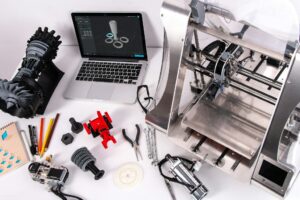3D Printing in Agriculture
Muhammad Yamin
Faculty of Agricultural Engineering & Technology, University of Agriculture, Faisalabad, Pakistan
In the ever-evolving landscape of agriculture, technological innovations are reshaping traditional practices. One such revolutionary technology making waves is 3D printing, an additive manufacturing method that brings a new dimension to the way we create, repair, and innovate in the farming sector. At its core, 3D printing is an additive manufacturing process that builds objects layer by layer from digital designs. Unlike traditional subtractive methods that involve cutting or molding materials, 3D printing allows for the creation of intricate and customized structures, opening up a world of possibilities.

The Role of 3D Printing in Agriculture
In agriculture, where precision and efficiency are paramount, 3D printing has found a significant role. One notable application is the fabrication of machine parts, especially for small implements used in farming. These parts can range from simple components to complex mechanisms, contributing to the optimization of various agricultural processes.
Example: 3D Printing in Seed Drill Metering Mechanism
A compelling example of 3D printing’s impact in agriculture is the creation of the metering mechanism in a seed drill. The metering mechanism is a critical component responsible for ensuring the precise distribution of seeds during planting. Traditional manufacturing processes might face challenges in producing intricate parts with the required precision, but 3D printing excels in this regard.
Advantages of 3D Printing in Agriculture
Customization: 3D printing allows farmers to customize parts according to their specific needs, adapting machinery for different crops and conditions.
Cost-Effectiveness: Traditional manufacturing processes can be expensive for producing low volumes of specialized parts. 3D printing offers a more cost-effective solution for small-scale production.
Rapid Prototyping: Farmers and engineers can quickly iterate and prototype new designs, accelerating the innovation cycle and leading to more efficient agricultural machinery.
On-Demand Manufacturing: With 3D printing, farmers can produce replacement parts on-site, reducing downtime and ensuring continuous operation during critical farming seasons.
Challenges and Considerations
While 3D printing presents exciting possibilities for agriculture, there are challenges to address. Material selection, ensuring structural integrity, and understanding the limitations of 3D-printed parts are crucial considerations. Additionally, embracing this technology may require training for farmers and technicians to harness its full potential.
Conclusion
As we witness the transformative power of 3D printing in agriculture, the prospect of creating custom, efficient, and cost-effective solutions for small implements becomes increasingly tangible. From the metering mechanism of a seed drill to various other applications, 3D printing is proving to be a game-changer in modernizing and enhancing precision in farming practices. As the technology continues to advance, the synergy between 3D printing and agriculture holds the promise of a more sustainable and efficient future for the farming industry.






